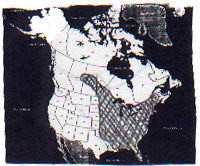Blue Jay - Profiles of Ravens Family:
Blue
Jay
Latin name: Cyanocitta
cristata
The noisy, flamboyant Blue Jay is common and
widespread, particularly where oak and pine forests are
predominant. In flight, its slow, shallow wingbeats alternate with
swooping glides.
Description
11-12.5" (28-32 cm). The head has a
prominent blue crest. The upperparts are blue with large white
spots on the wings and tail. The underparts are grayish-white with
a black necklace.
Voice
Extremely varied. Its common calls include a
loud, emphatic eeef eeef or thieef thieef, a
whistled too-weedle, too-weedle, and a low, mechanical,
guttural, rattling trrrrrrr. It often mimics other
birds.
Range
Central Alberta to Newfoundland, south to E.
Colorado, E. New Mexico, Se. Texas, Gulf Coast, and S. Florida. It
is rare in the northwest and often withdraws in winter from the
northern parts of its range.
 
|  This collection of student work is from Frank Keim's classes. He wants to share these works for others to use as an example of culturally-based curriculum and documentation. These documents have been OCR-scanned and are available for educational use only.
This collection of student work is from Frank Keim's classes. He wants to share these works for others to use as an example of culturally-based curriculum and documentation. These documents have been OCR-scanned and are available for educational use only.




